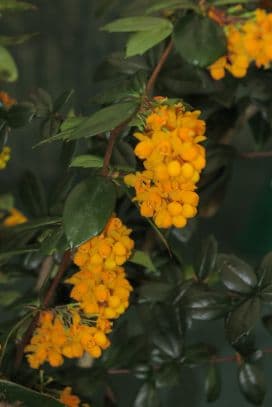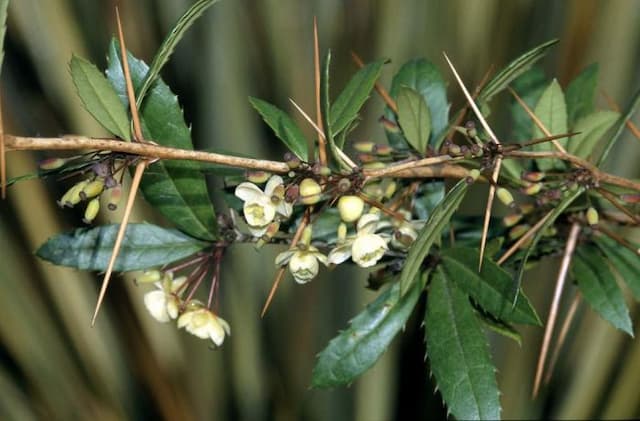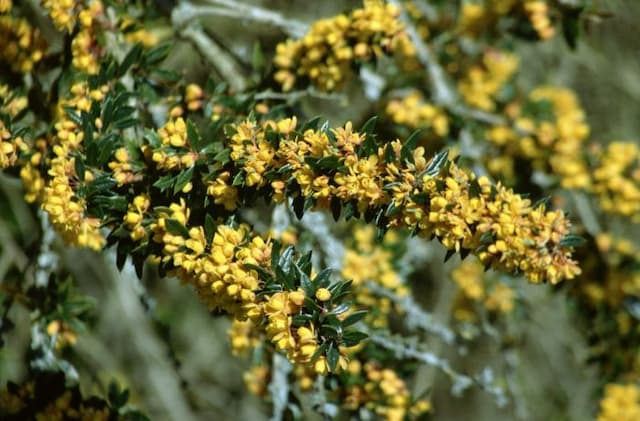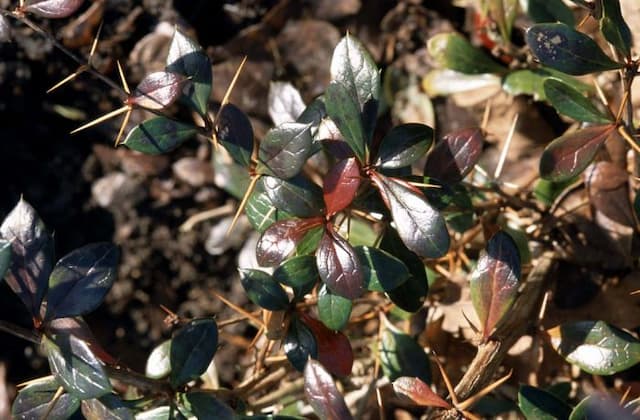Lolog barberry Berberis × lologensis 'Stapehill'

ABOUT
Berberis × lologensis 'Stapehill', commonly known as barberry, is a garden shrub with a notable appearance. This plant showcases richly colored foliage which is often a mix of deep green and burgundy, giving it a striking look throughout the year. The leaves of this barberry are small, oval-shaped to slightly spatulate, and they may have sharp edges along their margins. During the growing season, the barberry radiates vibrancy with its leaves that can sometimes turn to a stunning red or orange hue, particularly in the fall. This barberry is not just admired for its leaves but also for the bright yellow flowers that typically bloom in spring. The small, bell-shaped flowers cluster along the stems, offering a delightful contrast to the darker foliage. Following the flowering period, the barberry may produce small, oval berries. These berries can range in color from bright red to deep blue or even black, and they often remain on the plant well into winter, adding to the barberry's ornamental value throughout the colder months. The overall form of the barberry is dense and well-branched, with numerous stems that create a bushy appearance. It possesses a rugged texture due to the thorny branches, giving this plant a robust and hardy character. Eliminate any inconvenience posed by including specifications of the plant's dimensions.
About this plant
 Names
NamesSynonyms
Lologensis Barberry, Stapehill Barberry
Common names
Berberis × lologensis 'Stapehill'.
 Toxicity
ToxicityTo humans
Berberis, including the hybrid Berberis × lologensis 'Stapehill', may contain alkaloids that can be toxic to humans if ingested in significant quantities. Berberis species are known to have berberine, among other alkaloids, which can cause symptoms such as stomach upset, nausea, vomiting, diarrhea, dizziness, fainting, and respiratory problems. However, accidental ingestion of small amounts of berries or leaves typically leads to mild symptoms. It is still advised to always err on the side of caution and avoid eating any parts of Berberis plants.
To pets
Berberis plants, which include the hybrid Berberis × lologensis 'Stapehill', could be toxic to pets if ingested. The plant's berries, leaves, and stems may contain alkaloids such as berberine that can lead to gastrointestinal upset in animals, with potential symptoms being vomiting, diarrhea, lethargy, and abdominal pain. While these plants are not usually considered highly toxic to pets, consumption of large amounts can cause more severe symptoms and warrant veterinary attention. It is best to keep pets from eating any parts of Berberis plants to prevent any risk of poisoning.
 Characteristics
CharacteristicsLife cycle
Perennials
Foliage type
Evergreen
Color of leaves
Green
Flower color
Yellow
Height
4 feet [1.22 meters]
Spread
5 feet [1.52 meters]
Plant type
Shrub
Hardiness zones
7
Native area
Hybrid
Benefits
 General Benefits
General Benefits- Aesthetic Appeal: Adds visual interest to gardens with its colorful foliage and attractive fruit.
- Wildlife Habitat: Provides food and shelter for birds and other wildlife.
- Low Maintenance: Once established, requires minimal care beyond occasional pruning.
- Drought Tolerance: Able to withstand dry periods, making it suitable for xeriscaping.
- Erosion Control: Helps stabilize soil on slopes, reducing the risk of erosion.
- Privacy Screen: Due to its dense growth, it can be used as a hedge or privacy screen.
- Seasonal Interest: Offers year-round interest with its evergreen leaves and seasonal berries.
- Hardiness: Tolerant of cold temperatures, making it suitable for a variety of climates.
 Medical Properties
Medical PropertiesThis plant is not used for medical purposes.
 Air-purifying Qualities
Air-purifying QualitiesThis plant is not specifically known for air purifying qualities.
 Other Uses
Other Uses- Berberis × lologensis 'Stapehill', commonly known as Lolog barberry, can be used as a natural dye source for fabrics, providing a range of colors from yellow to deep orange depending on the mordant used.
- The wood of Lolog barberry is hard and dense, making it suitable for creating small woodcarvings or handles for tools and utensils.
- The thorns of Lolog barberry can be used as natural needles or pins for traditional crafts or for pinning botanical specimens.
- Lolog barberry bushes can be planted as a living barrier or hedge due to their dense growth habit and thorny branches, which can deter unwanted foot traffic and animal intruders.
- The berries of the Lolog barberry can be used as a food coloring agent or to add visual interest to culinary presentations.
- Lolog barberry's dense thicket provides shelter and nesting sites for birds and other small wildlife, enhancing biodiversity in garden settings.
- Due to the plant's tolerance for tough conditions, it can be used in erosion control projects to stabilize soil on slopes and prevent landslides.
- The bright yellow fall foliage of Lolog barberry adds a seasonal interest in landscape design, providing a striking contrast against evergreen plants.
- Cut branches of Lolog barberry can be included in floral arrangements for their interesting form and texture, adding a unique touch to bouquets.
- The plant can be used in educational gardens or botanical collections to demonstrate examples of hybrid vigor or the variability in plant breeding.
Interesting Facts
 Feng Shui
Feng ShuiThe Berberis is not used in Feng Shui practice.
 Zodiac Sign Compitability
Zodiac Sign CompitabilityThe Berberis is not used in astrology practice.
 Plant Symbolism
Plant Symbolism- Protection: Many Berberis species, including the Berberis × lologensis 'Stapehill', have sharp thorns, which have traditionally symbolized protection and defense, symbolizing the plant's ability to safeguard a space.
- Resilience: This plant is known for its hardiness and ability to thrive in various conditions, representing a person's ability to endure challenges and overcome obstacles.
- Sharpness: The thorns of the Berberis can also represent a sharp or biting nature, potentially symbolizing the need for boundaries or a sharp intellect.
 Water
WaterLologensis Barberry prefers evenly moist soil, so it's essential to establish a regular watering schedule. It should be watered deeply once a week, providing about 1 to 1.5 inches of water each time. During periods of extreme heat or drought, watering frequency should be increased to twice a week. Adjust watering based on rainfall, lessening the amount if there has been significant precipitation. Always allow the top inch of soil to dry out before watering again to prevent over-watering and root rot.
 Light
LightLologensis Barberry thrives best in full sun to partial shade. It should be planted in a location where it will receive at least 6 hours of sunlight daily. Some afternoon shade can be beneficial in protecting the plant from the intense heat of late summer days.
 Temperature
TemperatureLologensis Barberry is hardy in a range of temperatures and can tolerate minimum temperatures down to about 0 degrees Fahrenheit. The ideal growing temperature for this plant is between 60 to 70 degrees Fahrenheit. However, it can survive maximum temperatures well into the 90s Fahrenheit as long as adequate watering is provided.
 Pruning
PruningLologensis Barberry should be pruned to remove any dead or damaged branches and to shape the plant, typically in late winter or early spring before new growth starts. Pruning can also be done after flowering to maintain the desired size and to encourage bushier growth. It's important not to over-prune, as this can reduce flowering and fruiting.
 Cleaning
CleaningAs needed
 Soil
SoilThe best soil mix for Berberis × lologensis 'Stapehill', commonly known as the Lolog Barberry, should be well-draining with some organic matter. A mix of garden soil, peat moss, and perlite or sand would promote healthy growth. The ideal soil pH for this cultivar should be slightly acidic to neutral, ranging from 5.5 to 7.5.
 Repotting
RepottingLolog Barberry typically does not require frequent repotting as it is a slow-growing plant. It should generally be repotted every 3 to 4 years or when the roots have filled the existing container, ensuring new room for growth and fresh soil.
 Humidity & Misting
Humidity & MistingThe Lolog Barberry prefers moderate humidity levels but is adaptable to various humidity conditions in the outdoor environment. As long as the soil moisture is well-regulated, the plant should be resilient to the surrounding humidity levels.
 Suitable locations
Suitable locationsIndoor
Grow in bright light, well-drained soil, moderate water.
Outdoor
Plant in sun to part-shade, well-drained soil, water regularly.
Hardiness zone
7-9 USDA.
 Life cycle
Life cycleBerberis × lologensis 'Stapehill', commonly known as the Lolo Barberry, begins its life cycle as a seed that germinates in the soil under the right conditions of warmth and moisture. The seedling emerges and develops into a young plant, establishing a root system and growing its first leaves. As the plant matures, it grows into a shrub with characteristic spiny leaves and branches; it enters the vegetative growth stage where it focuses energy on expanding its size and reach. Upon reaching maturity, the Lolo Barberry produces flowers, typically in the spring, which are pollinated by insects, leading to the development of small, oval berries that turn from green to deep purple or black when ripe. The berries contain seeds, which once dispersed—either by falling to the ground or by being eaten and then excreted by birds—begin a new life cycle. As a perennial, this Barberry will continue to grow and produce flowers and fruit annually for many years until the end of its life span, when it will eventually succumb to environmental stress or old age.
 Propogation
PropogationPropogation time
Spring-Early Summer
The Berberis × lologensis 'Stapehill', commonly known as Barberry, is most often propagated through semi-hardwood cuttings. The ideal time to take cuttings is in the late summer when new growth has begun to mature and harden slightly. To propagate by cuttings, one would snip a 4 to 6-inch length (about 10 to 15 centimeters) from a healthy branch, ensuring a few sets of leaves remain on the cutting. The lower leaves are removed, and the cut end dipped in rooting hormone to encourage root development. The cutting is then planted in a mixture of peat and perlite or sand to provide adequate drainage and moisture retention, while keeping it out of direct sunlight and ensuring the soil remains moist. Roots typically begin to form in a few weeks, after which the new Barberry plant can be transplanted to a more permanent location.








![Japanese barberry [Bonanza Gold]](/_next/image?url=https%3A%2F%2Fplants-admin.emdemapps.com%2Fimages%2Fplants%2F%2Fimages%2F604b5385e413f.png&w=640&q=75)
